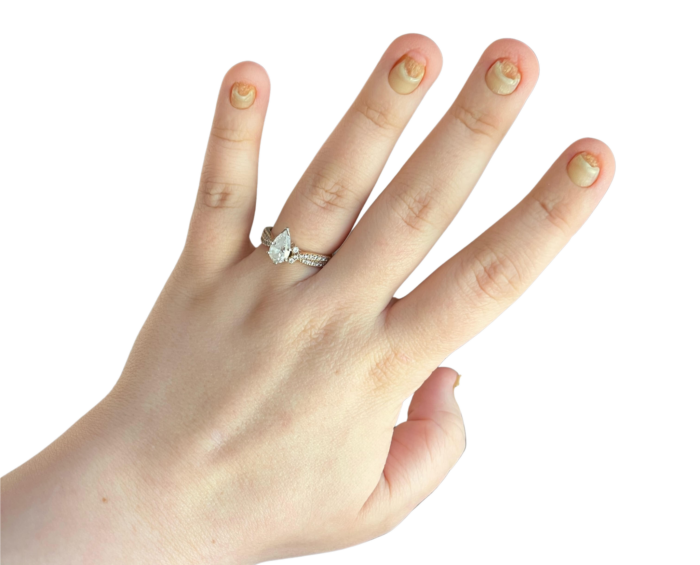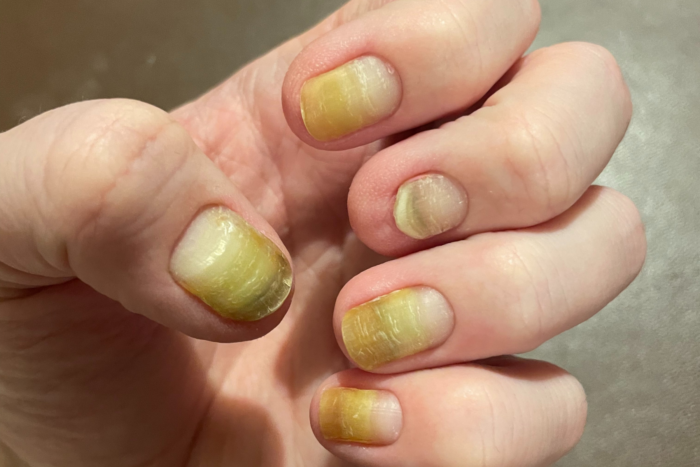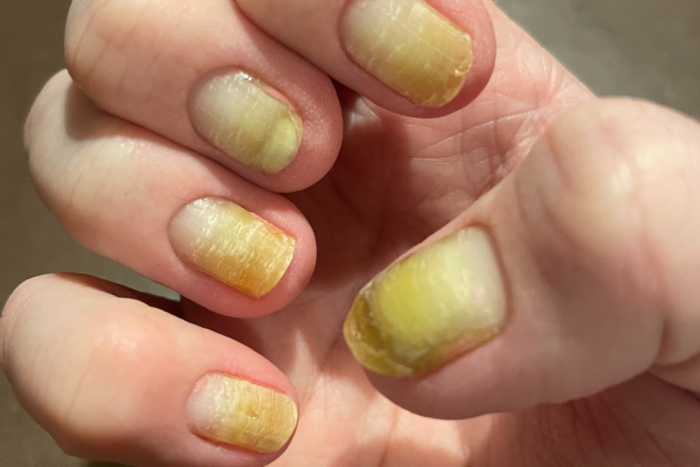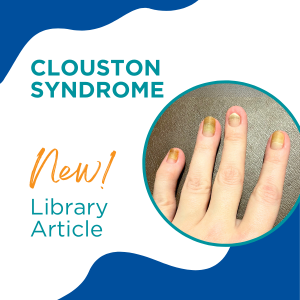In the ectodermal dysplasias community, we talk a lot about how the conditions affect the hair, teeth, sweat glands and skin. But, we probably talk the least about the nails. They may not be affected in some types of ectodermal dysplasias while other types have mild nail issues.
But nail abnormalities are one of the two classic features (hair being the second) of Clouston syndrome, which can also be called hidrotic ectodermal dysplasia. (This is not to be confused with hypohidrotic ectodermal dysplasia.) In our new library article, you can learn more in-depth information about how the nails can be affected and the best ways to treat them.
Download Nail Treatment ArticleBecause the nails can be profoundly impacted, we asked our Clouston syndrome community to share their experience and explain what it’s like. Our question drew an emotional response from many women who shared how alone they felt in having nails that were different. One said she felt less alone just knowing we had asked the question. Several were eager to share their stories. Below, read about three women’s nail journeys with Clouston syndrome.
Amanda Brown-Hayes, Indiana

Growing up, I really didn’t notice a difference (in my nails) until I entered school. Once I was in school, it was a constant challenge. I was often teased because my fingernails were different. I specifically remember a term that was used in a derogatory fashion—“nail woman”—or kids would just say they looked dirty. Still to this day, as a 42-year-old woman, people often say things like “what is wrong with your nails?” or “stop biting your nails.”
When I was younger, it had a great effect on my self-esteem and always made me feel like I couldn’t be “pretty” like other girls. School was a place I hated and never felt like I fit in. There was a brief period in my early teens when I went to a salon and got acrylic or “fake” nails. While I loved the look, it ended up being a nightmare because if they hit anything it would pull my natural nail completely off the bed and be a bloody, painful mess that would take over a year to begin growing back.

In adulthood, I have learned to deal with it in various ways, mostly by just developing my own sense of self confidence. Often times when I start a new job or meet new people, I just put it out there right away if I see them looking. I say that I was born with a genetic condition that affects the hair and nails, and that usually works. If people ask questions, I am willing to answer, but I have found most people have no idea about it. Even most doctors I’ve had over the years have no idea what ectodermal dysplasia is, and I’ve found myself educating them. Finding the National Foundation for Ectodermal Dysplasias (NFED) in my mid 20s has given me a place to get consistent information for myself and others, and I’m so grateful it’s available.
Keep Nails Short
About half of my nails are really thick, with ridges on them and are somewhat discolored. The other half are thin with ridges and discolored. When I was young, I had fingernails on all ten fingers, but over the years I have pulled them off during injuries and now only six of them still grow. The other four never reach a length that stays because I believe the nail bed has just become damaged. Due to the raised nature of my nails, they catch easily on things during simple everyday tasks and have pulled up or off so many times. When this happens it is incredibly painful, and usually a bloody mess. I choose to just keep them short to avoid this because I’m required to use my hands a lot in my line of work.
I am a registered nurse so I wash and sanitize them all day every day, which causes the skin to be very dry and rough. My fingertips are very sensitive to cold in the winter, and if I don’t moisturize and protect them, they are prone to cracking at the tips. Quality, thick lotions and hand creams have always been an important part of my personal self-care routine. My skin on my hands, feet and elbows is thicker than the rest of my body, can be red, and rough. I use foot peel masks on my feet which has helped so much.
I honestly think the biggest impact over my lifetime has been on my self-esteem due to ignorant people. I always wanted to be one of those girls who could have pretty flashy nail colors. I have just found other ways to express myself through makeup or clothes. But when I was young, I hadn’t developed a sense of self yet, and peer groups and acceptance are such a big part of that for young people.
– Amanda
Everyone Has Beauty
Now that I’m older, I realize that everyone has beauty, and almost everyone has things they would like to change. I sadly believe the media and sites like Instagram have made this feeling of wanting to be “perfect” an unattainable goal for people growing up in this society, largely contributing to the mental health crisis we see in teens these days. Finding the NFED Adult Women’s Group on Facebook has also been helpful. Ectodermal dysplasia is so rare that a person could go their entire life without meeting another person affected who’s not a direct family member. It’s great to have a place where I can connect with other women where we can share our experiences and talk about different ways to live a happy healthy life with this condition in regards to things like hair, nails, comorbidities, and also the likelihood of inheritance to our children.
Kaitlyn Richardson Schwartz, Washington

I have Clouston syndrome. My nails are thick, raised and discolored. They are so sensitive to the cold—sometimes it’s unbearable when it’s cold outside. The best way my family describes it is that it feels like an open raw nerve. I am more insecure about my nails than my hair. Everyone notices nails and growing up I HATED them. I still am not fond of them but have learned how to live with it and cope the best way I can by filing them down, cleaning them and painting my nails.

They also can get so thick and raised that they can get caught and rip off. It’s beyond painful so I tend to keep mine cut so that doesn’t happen. I do wish I could go to a salon and have my nails done, but to me, it’s not worth the discourse that it’s not a fungus or contagious. That is where everyone’s minds go when they see the nails, and it can feel really embarrassing.
Michelle Robertson, United Kingdom
I was not diagnosed by a professional. It was my own research in my 30s that led me to this condition and this support network. I am affected with alopecia and nail abnormalities. My nails in particular are discolored—a brown/yellow color. They separate from the nail bed very far down, which leaves them at risk of breaking or being ripped from the nail bed very easily. If they get knocked, the pain in them can throb for hours. Ripping them off hurts so much and they bleed and take an age to regrow. I also get pain in them when they are cold.


Growing up was so difficult—always feeling different from my friends. The only people I knew who were the same as me were my mum and brother and a couple of members of my wider family. I’ve never found anything to particularly help my nails. I try to keep them to the length just below the top of my finger to lessen the risk of catching them, as it’s so easy to do.
They make me super self-conscious, and the only thing I find to help me with that is to have them painted, usually in lighter colors in case any are broken as it draws less attention to them. I never thought anyone would love me with them, and I worried about having kids for the fear of passing the condition on. But I am loved, and I have two beautiful children. My son definitely has the same condition. My daughter’s hair has grown back a lot earlier, and it’s hard to tell with her nails, as she bites them. But either way, I know how they feel and can help them through it.
We’ve got each other and knowing this wider community is here is massive for me. I don’t feel so alone anymore.
– Michelle
Resources to Help You
It’s evident from their stories that the nails can cause not only physical but emotional pain, too. If you share this symptom, hopefully the information in our new library article along with these women’s tips, will help you. As always, you can call our office to talk to our staff if you have questions. If you are a woman affected by Clouston syndrome, you may want to join our private Facebook group for adult women who are affected by any type of ectodermal dysplasia.
Do you experience nail abnormalities? Tell us below what type of ectodermal dysplasia affects you and how your nails have impacted your life.

Wow, these women understand me! They have described precisely what I and my family deal with.
I occasionally deal with infections in the nail bed, and one tip I would give in dealing with those is to regularly spray my nails with hydrogen peroxide. That seems to help my nails have more natural coloring, too.
these stories describe my nails hands and toes. myhar does not grow beyond 2 or 3 inches.
I am 72 my son is 50 he is having a hard time with getting a job because he has never been diagnosed by a dr and they want him to do a hair test for drugs. That is not possible when he can’t grow hair and they refuse to do a urine test.
What do we do now? they want over $400.00 and he has no money.
This is very challenging, Agnes, and I’m sorry to hear about this challenge. I wonder if there are any employee advocates in your area that might be able to provide advice to your son on how to manage this issue? I’m sorry we don’t have better advice. Best of luck! – Veronica
I was born with Clouston Syndrome. I didn’t know that I was “different” until I stepped on the bus in first grade. I was the “bald girl with weird fingernails”. It has taken me 72 years to finally like myself. My Dad was the carrier, and if you didn’t talk about it…it didn’t exist. I can’t imagine my Mom’s pain as she tried to comfort me after an extremely difficult day in school and I threw myself in her arms and cried “Why did God make me like this?! I wish I was dead.” Mumma, in her beautiful way said “Honey, God could have made you without arms and legs.” Well, I HAD arms and legs! I DIDN’T have hair and it was torturous. My Mom died last April and I slept with her a couple of nights before she passed. Long story short, she said to me “I know that you’ve never thought so, but I’ve a.ways thought you’re beautiful.” 😭💔
The bullying comments resonate so hard. I hated hearing being called bald. Even little kid pointing it out was hard. As a safety mechanism i learned how to paint my nails really really heigh ĥ and detailed to help hide it.